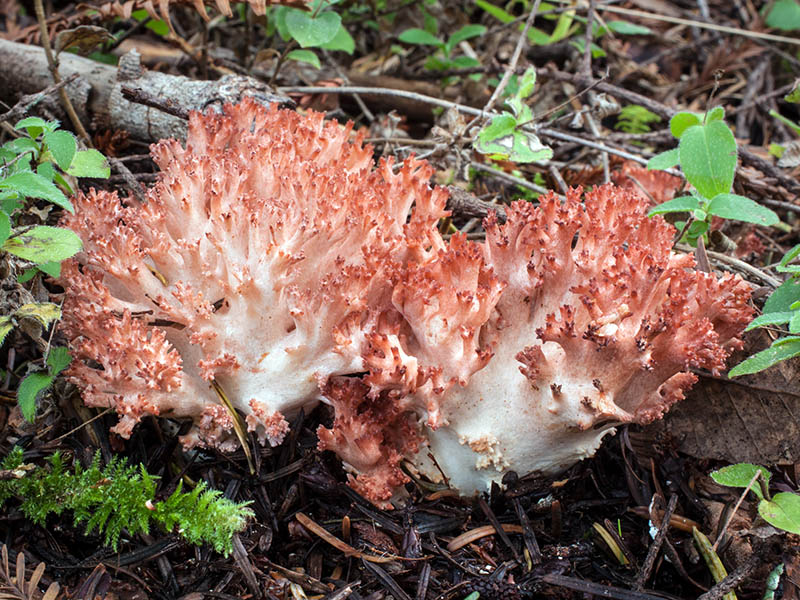Ramaria botrytis
Vademecum 253. 1918.
Common Name: none
-
Sporocarp
Fruiting body 8-22 cm tall, 10-25 cm broad, coralloid, intricately branched from a large fleshy base; branches spreading and elongating in age, white to creamy-white when young, yellowish white in age; branch tips vinaceous- red when young, fading in age to pallid buff, with only the immature lower branch tips showing the vinaceous tones; flesh white, brittle; odor and taste mild.
-
Stipe
Stipe 2-6 cm thick, short, compact, tapering downward; white to yellowish in age; not bruising or discoloring.
-
Spores
Spores 11-15 x 4-6 m, elongate-elliptical, with longitudinally striate slightly spiraled ridges and irregularly roughened. Spore deposit pale ochraceous to ochraceous-buff.
-
Habitat
Solitary, scattered, or in rings in mixed hardwood conifer forests; from fall to mid-winter.
-
Edibility
 Edible and good, for most people.
Edible and good, for most people. -
Comments
Ramaria botrytis is one of the largest of the coral fungi and is considered an excellent edible by some mycophagists. It is distinguished by its size and white to creamy, vinaceous tipped, branches which fade in age. Close relatives include Ramaria strasseri, which also has a large massive base and longitudinally striate spores, but it is more yellowish to tan in color, and lacks vinaceous colored branch tips during all stages of growth. Another species, Ramaria botrytoides, is rare, has coral-pink branch tips, tough gelatinous flesh, and is usually not found south of Mendocino Co. It has irregularly roughened spores that are not striate.
-
References
Arora, D. (1986). Mushrooms Demystified. Ten Speed Press: Berkeley, CA. 959 p.
Breitenbach, J. & Kränzlin, F. (1986). Fungi of Switzerland. Volume 2: Non-Gilled Fungi. Verlag Mykologia: Luzern, Switzerland. 412 p.
Corner, E.J.H. (1950). A Monograph of Clavaria and Allied Genera. Oxford University Press: London, England. 740 p.
Desjardin, D.E., Wood, M.G. & Stevens, F.A. (2015). California Mushrooms: The Comprehensive Identification Guide. Timber Press: Portland, OR. 560 p.
Ellis, M.B. & Ellis, J.P. (1990). Fungi without Gills (Hymenomycetes and Gasteromycetes). Chapman and Hall: London, England. 329 p.
Exeter, R.L., Norvell, L. & Cázares, E. (2006). Ramaria of the Pacific Northwestern United States. United States Department of Interior, Bureau of Land Management: Salem, OR. 157 p. (PDF)
Marr, C.D. & Stuntz, D.E. (1973). Ramaria of Western Washington (Bibliotheca Mycologica, Band 38). J. Cramer: Vaduz, Liechtenstein. 232 p.
Siegel, N. & Schwarz, C. (2016). Mushrooms of the Redwood Coast. Ten Speed Press: Berkeley, CA. 601 p. -
Other Descriptions and Photos
- Michael Wood: Ramaria botrytis (CP)

- Michael Wood: Ramaria botrytis (CP)

- Ronald L. Exeter: Ramaria botrytis (CP)

- Ronald L. Exeter: Ramaria botrytis (CP)
- Currie D. Marr: Ramaria botrytis CP)
- Currie D. Marr: Ramaria botrytis CP)
- Taylor F. Lockwood: Ramaria botrytis (CP)
- Taylor F. Lockwood: Ramaria botrytis (CP)
- Fred Stevens: Ramaria botrytis (CP)

- Mushroom Observer: Ramaria botrytis (CP)
- MushroomExpert.com: Ramaria botrytis (D & CP)
- Wikipedia: Ramaria botrytis (D & CP)
- Rogers Mushrooms: Ramaria botrytis (D & CP)
- Page perso de JJ.Wuilbaut: Ramaria botrytis (CP)
- Page perso de JJ.Wuilbaut: Ramaria botrytis (CP)
- Arora (1986): p. 656 (D & P)
- Arora (1991): p. 211 (D & CP)
- Jordan: p. 88 (D & CP)
- Lincoff: p. 407 (D), plate 749 (CP)
- Miller: sp 274 (D)
- Smith: sp. 49 (D & CP)
- Michael Wood: Ramaria botrytis (CP)
